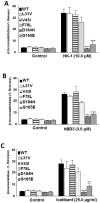Naturally Occurring Missense MRGPRX2 Variants Display Loss of Function Phenotype for Mast Cell Degranulation in Response to Substance P, Hemokinin-1, Human β-Defensin-3, and Icatibant
- PMID: 29794017
- PMCID: PMC6039248
- DOI: 10.4049/jimmunol.1701793
Naturally Occurring Missense MRGPRX2 Variants Display Loss of Function Phenotype for Mast Cell Degranulation in Response to Substance P, Hemokinin-1, Human β-Defensin-3, and Icatibant
Abstract
Human mast cells (MCs) express a novel G protein-coupled receptor (GPCR) known as Mas-related GPCR X2 (MRGPRX2). Activation of this receptor by a diverse group of cationic ligands such as neuropeptides, host defense peptides, and Food and Drug Administration-approved drugs contributes to chronic inflammatory diseases and pseudoallergic drug reactions. For most GPCRs, the extracellular (ECL) domains and their associated transmembrane (TM) domains display the greatest structural diversity and are responsible for binding different ligands. The goal of the current study was to determine if naturally occurring missense variants within MRGPRX2's ECL/TM domains contribute to gain or loss of function phenotype for MC degranulation in response to neuropeptides (substance P and hemokinin-1), a host defense peptide (human β-defensin-3) and a Food and Drug Administration-approved cationic drug (bradykinin B2 receptor antagonist, icatibant). We have identified eight missense variants within MRGPRX2's ECL/TM domains from publicly available exome-sequencing databases. We investigated the ability of MRGPRX2 ligands to induce degranulation in rat basophilic leukemia-2H3 cells individually expressing these naturally occurring MRGPRX2 missense variants. Using stable and transient transfections, we found that all variants express in rat basophilic leukemia cells. However, four natural MRGPRX2 variants, G165E (rs141744602), D184H (rs372988289), W243R (rs150365137), and H259Y (rs140862085) failed to respond to any of the ligands tested. Thus, diverse MRGPRX2 ligands use common sites on the receptor to induce MC degranulation. These findings have important clinical implications for MRGPRX2 and MC-mediated pseudoallergy and chronic inflammatory diseases.
Copyright © 2018 by The American Association of Immunologists, Inc.
Figures






Similar articles
-
Identification of Gain and Loss of Function Missense Variants in MRGPRX2's Transmembrane and Intracellular Domains for Mast Cell Activation by Substance P.Int J Mol Sci. 2019 Oct 23;20(21):5247. doi: 10.3390/ijms20215247. Int J Mol Sci. 2019. PMID: 31652731 Free PMC article.
-
Angiogenic Host Defense Peptide AG-30/5C and Bradykinin B2 Receptor Antagonist Icatibant Are G Protein Biased Agonists for MRGPRX2 in Mast Cells.J Immunol. 2019 Feb 15;202(4):1229-1238. doi: 10.4049/jimmunol.1801227. Epub 2019 Jan 16. J Immunol. 2019. PMID: 30651343 Free PMC article.
-
Small-Molecule Host-Defense Peptide Mimetic Antibacterial and Antifungal Agents Activate Human and Mouse Mast Cells via Mas-Related GPCRs.Cells. 2019 Apr 3;8(4):311. doi: 10.3390/cells8040311. Cells. 2019. PMID: 30987258 Free PMC article.
-
Emerging Roles for MAS-Related G Protein-Coupled Receptor-X2 in Host Defense Peptide, Opioid, and Neuropeptide-Mediated Inflammatory Reactions.Adv Immunol. 2017;136:123-162. doi: 10.1016/bs.ai.2017.06.002. Epub 2017 Jul 24. Adv Immunol. 2017. PMID: 28950944 Review.
-
Roles of Mas-related G protein-coupled receptor X2 on mast cell-mediated host defense, pseudoallergic drug reactions, and chronic inflammatory diseases.J Allergy Clin Immunol. 2016 Sep;138(3):700-710. doi: 10.1016/j.jaci.2016.04.051. Epub 2016 Jul 20. J Allergy Clin Immunol. 2016. PMID: 27448446 Free PMC article. Review.
Cited by
-
Identification of Gain and Loss of Function Missense Variants in MRGPRX2's Transmembrane and Intracellular Domains for Mast Cell Activation by Substance P.Int J Mol Sci. 2019 Oct 23;20(21):5247. doi: 10.3390/ijms20215247. Int J Mol Sci. 2019. PMID: 31652731 Free PMC article.
-
Revisiting the role of MRGPRX2 on hypersensitivity reactions to neuromuscular blocking drugs.Curr Opin Immunol. 2021 Oct;72:65-71. doi: 10.1016/j.coi.2021.03.011. Epub 2021 Apr 12. Curr Opin Immunol. 2021. PMID: 33857758 Free PMC article. Review.
-
Mast Cell-Specific MRGPRX2: a Key Modulator of Neuro-Immune Interaction in Allergic Diseases.Curr Allergy Asthma Rep. 2021 Jan 4;21(1):3. doi: 10.1007/s11882-020-00979-5. Curr Allergy Asthma Rep. 2021. PMID: 33398613 Free PMC article. Review.
-
MRGPRX2 Activation by Rocuronium: Insights from Studies with Human Skin Mast Cells and Missense Variants.Cells. 2021 Jan 15;10(1):156. doi: 10.3390/cells10010156. Cells. 2021. PMID: 33467419 Free PMC article.
-
Hypersensitivity reactions to small molecule drugs.Front Immunol. 2022 Nov 10;13:1016730. doi: 10.3389/fimmu.2022.1016730. eCollection 2022. Front Immunol. 2022. PMID: 36439170 Free PMC article. Review.
References
-
- Tatemoto K, Nozaki Y, Tsuda R, Konno S, Tomura K, Furuno M, Ogasawara H, Edamura K, Takagi H, Iwamura H, Noguchi M, Naito T. Immunoglobulin E-independent activation of mast cell is mediated by Mrg receptors. Biochem Biophys Res Commun. 2006;349:1322–1328. - PubMed
Publication types
MeSH terms
Substances
Grants and funding
LinkOut - more resources
Full Text Sources
Other Literature Sources

